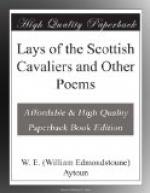“William R.—As for M’Ian of Glencoe, and that tribe, if they can be well distinguished from the rest of the Highlanders, it will be proper for public justice to extirpate that set of thieves.” “W.R.”
This letter is remarkable as being signed and countersigned by William alone, contrary to the usual practice. The Secretary was no doubt desirous to screen himself from after responsibility, and was further aware that the royal signature would insure a rigorous execution of the sentence.
Macdonald, or, as he was more commonly designed, M’Ian of Glencoe, was the head of a considerable sept or branch of the great Clan-Coila, and was lineally descended from the ancient Lords of the Isles, and from the royal family of Scotland—the common ancestor of the Macdonalds having espoused a daughter of Robert II. He was, according to a contemporary testimony, “a person of great integrity, honour, good nature, and courage; and his loyalty to his old master, King James, was such, that he continued in arms from Dundee’s first appearing in the Highlands, till the fatal treaty that brought on his ruin.” In common with the other chiefs, he had omitted taking the benefit of the indemnity until he received the sanction of King James: but the copy of that document which was forwarded to him, unfortunately arrived too late. The weather was so excessively stormy at the time that there was no possibility of penetrating from Glencoe to Inverara, the place where the sheriff resided, before the expiry of the stated period; and M’Ian accordingly adopted the only practicable mode of signifying his submission, by making his way with great difficulty to Fort-William, then called Inverlochy, and tendering his signature to the military Governor there. That officer was not authorised to receive it, but at the earnest entreaty of the chief, he gave him a certificate of his appearance and tender, and on New-Year’s day, 1692, M’Ian reached Inverara, where he produced that paper as evidence of his intentions, and prevailed upon the sheriff, Sir James Campbell of Ardkinglass, to administer the oaths required. After that ceremony, which was immediately intimated to the Privy Council, had been performed, the unfortunate gentleman returned home, in the full conviction that he had thereby made peace with government for himself and for his clan. But his doom was already sealed.
A company of the Earl of Argyle’s regiment had been previously quartered in Glencoe. These men, though Campbells, and hereditarily obnoxious to the Macdonalds, Camerons, and other of the loyal clans, were yet countrymen, and were kindly and hospitably received. Their captain, Robert Campbell of Glenlyon, was connected with the family of Glencoe through the marriage of a niece, and was resident under the roof of the chief. And yet this was the very troop selected for the horrid service.
Special instructions were sent to the major of the regiment, one Duncanson, then quartered at Ballachulish—a morose, brutal, and savage man—who accordingly wrote to Campbell of Glenlyon in the following terms:—




